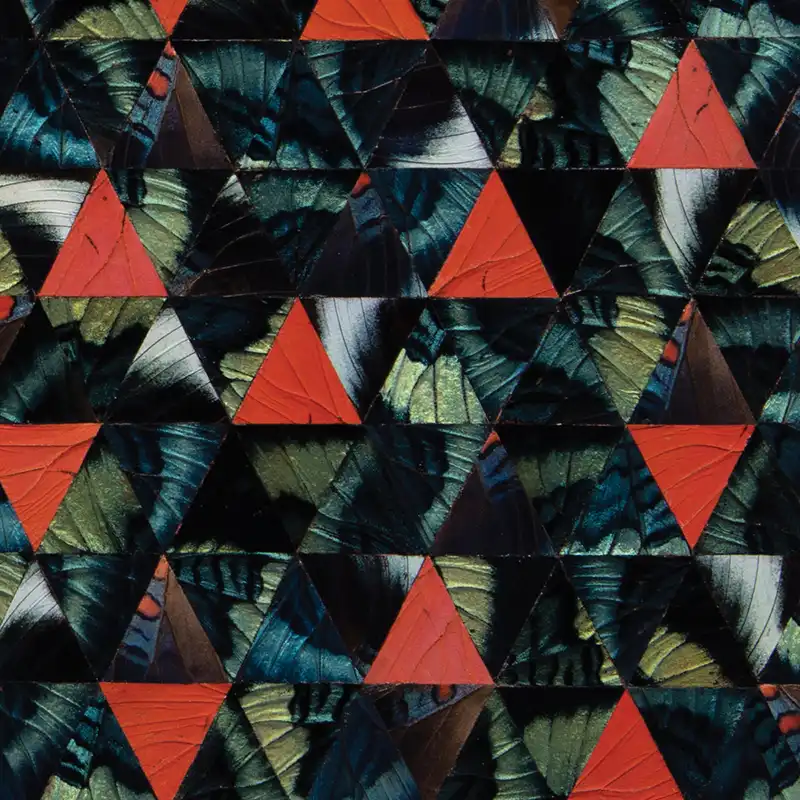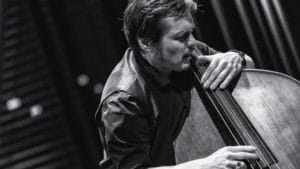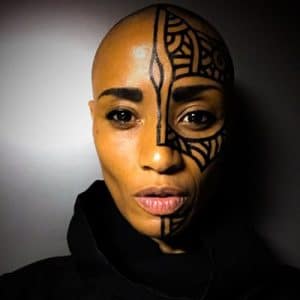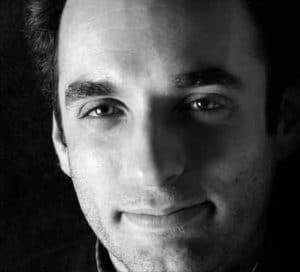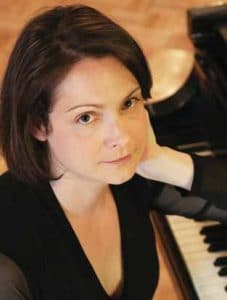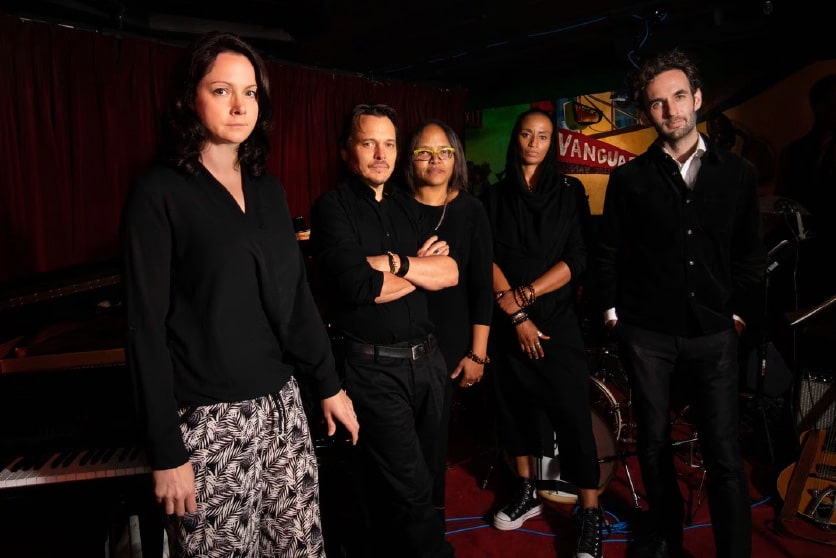
Kris Davis and her bandmates at the Village Vanguard in 2022. From left: Davis, Trevor Dunn, Terri Lyne Carrington, Val Jeanty, and Julian Lage. - photo by Caroline Mardok
Pianist Kris Davis’s explorations can lead just about anywhere
For a while now, Kris Davis has been a go-to player for bandleaders in jazz’s progressive wing: a pianist who can play inside or “out,” who can lead the charge in a passage of hard-driving swing or help set the course in group explorations of the unknown — the heady, uncharted waters of free collective improvisation.
During her two decades in New York, Davis’s presence on the bandstand was a kind of bellwether. “Over the last couple of years,” The New York Times’ Ben Ratliff wrote in 2010, “one method for deciding where to hear jazz on a given night has been to track down the pianist Kris Davis.”
That was then. These days, Davis’s prominence has been assured: as a perennial critics poll winner leading a plethora of varied projects, head of her own record label, and, for the past four years, as associate program director of creative development for Berklee College of Music’s visionary Institute of Jazz and Gender Justice, founded by drummer, bandleader, and educator Terri Lyne Carrington. She plays regularly with Carrington (with whom she won a Grammy for 2022′s “New Standards, Vol. 1″), and this year was recruited by the revered bassist and composer Dave Holland to be part of his new quartet, which made its inaugural Newport Jazz Festival appearance in August. She will be playing in saxophonist Walter Smith III’s band at the reopening of Regattabar on Sept. 15.
And on Friday, Davis releases “Live at the Village Vanguard,” as one of only a handful of women instrumentalists to lead recording sessions at that storied New York club. (The release coincides with a cover story in venerable jazz magazine DownBeat as part of its “Beyond” issue.)
The album continues the work of Davis’s highly acclaimed 2019 release, “Diatom Ribbons” (both on her Pyroclastic Records) with some of the players from that CD — Carrington, bassist Trevor Dunn, and turntablist/electronic musician Val Jeanty, plus guitarist Julian Lage. The live album’s notes suggest Davis’s broad range of reference: jazz composers from Charlie Parker and Eric Dolphy to Ronald Shannon Jackson, Wayne Shorter, and Geri Allen, to 20th-century modernist classical giant Olivier Messiaen. Throughout the album, there are drop-in snippets of archival recorded interviews with the likes of Messiaen, Sun Ra, and another avant-garde classical titan, Karlheinz Stockhausen.
As that lineup indicates, much of Davis’s career has been spent exploring the knottier terrains of the avant-garde — jazz standards and free improvisation informed by European modernism. Davis has spoken of Diatom Ribbons — which began as a studio project and album, with different configurations of musicians on each of its tracks — as a way to take her interests into more groove-based music. So, among the 10 tracks on that studio album are rock and funk vamps, a bit of Latin groove, and one all-out skronk fest featuring guitarists Marc Ribot and Nels Cline.
The Vanguard live set is more of a sprawl, its 11 tracks spread over two CDs. Despite some clearly defined forms (including two takes of Shorter’s “Dolores”), there’s more of an inclination to wander into unplanned spaces.
“[For ‘Diatom Ribbons’] we all met in the studio and learned the pieces and recorded two or three takes, and that was it,” Davis says. “Whereas with the live album, we’d been playing all week at the Vanguard and getting to workshop the music and try different things with it. So I was also able to bring in some harder music that’s just not possible when you’re trying to read something and record it 20 minutes later. So things like ‘VW,’ we had more time to rehearse it and then also play it every day.”
That tune’s understated funk, with its interlocking off-kilter patterns of piano, bass, and guitar (with Ra intoning about music “from another dimension”), provides a good example of Davis’s meticulous approach. Similarly, the delicate “Brainfeel” twines evocative melody lines, supported by Carrington’s soft cymbal hits and Jeanty’s atmospheric electronic washes. These stand in stark contrast to the go-for-broke versions of “Dolores” or the aggressive rock beats of “Kingfisher.”
Davis’s combination of meticulously written forms with what she calls the “collective composition” associated with free jazz requires her to work with like-minded musicians who are good readers and quick studies but also “OK with not going with a plan.”
For esteemed veteran Carrington, Davis fed a hunger for new musical territory. “I was looking for more opportunities to play more open music. And what I really loved about her music is the openness, but also her sense of time and rhythm — within no time, within an open structure, I could still hear and feel that she had incredible timing and incredible sense of rhythm. And for me, that was kind of exactly what I was trying to have more of in my life.”
Adds Carrington, “She’s a masterful musician and an original, masterful composer.”
Carrington invited Davis to join her and bassist/vocalist Esperanza Spalding in a memorial tribute to Allen, who died in 2017. Playing with them and Jeanty, Davis considered the Diatom Ribbons project as a way to introduce her new community of friends to members of her New York crowd, like Dunn and saxophonist Tony Malaby (also on the “Diatom Ribbons” album, and now a Berklee associate professor).
“There’s something about it [Diatom Ribbons] that speaks to everybody and what their comfort zone is,” says Davis, “but also maybe pushes them into some challenging situations. I thought they would make good music together.”
For Carrington, hiring Davis for the Institute of Jazz and Gender Justice — which not only teaches varied work by female jazz composers like those on “New Standards, Vol. 1,” but also leads discussions about the place of women and nonbinary musicians in the jazz community — was a no-brainer. Her musical openness was of a piece with her social attitude. Though Davis is known as an experimenter, says Carrington, “she’s not afraid of tradition. She welcomes everything. So she can teach from that perspective and play from that perspective.”

